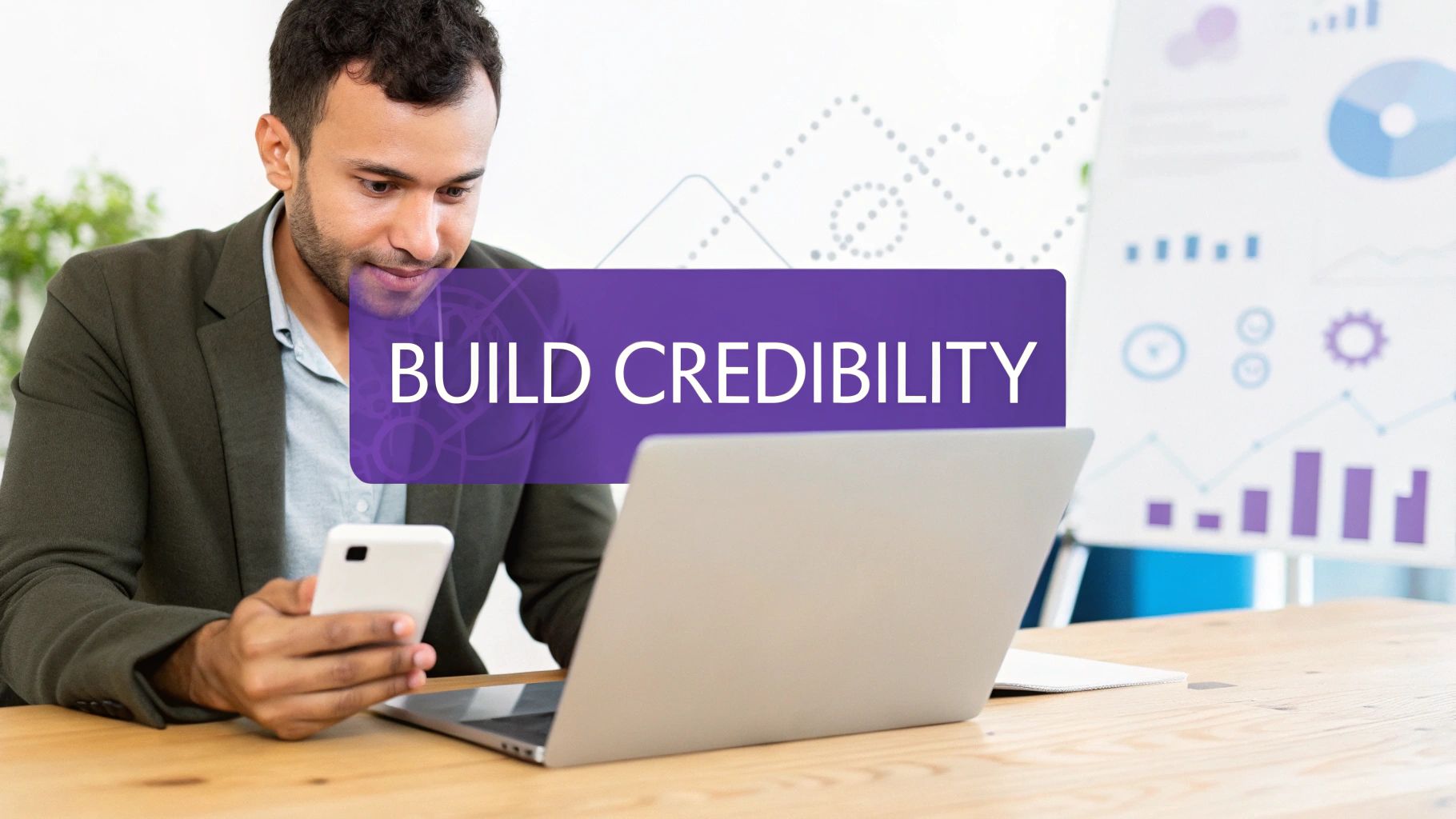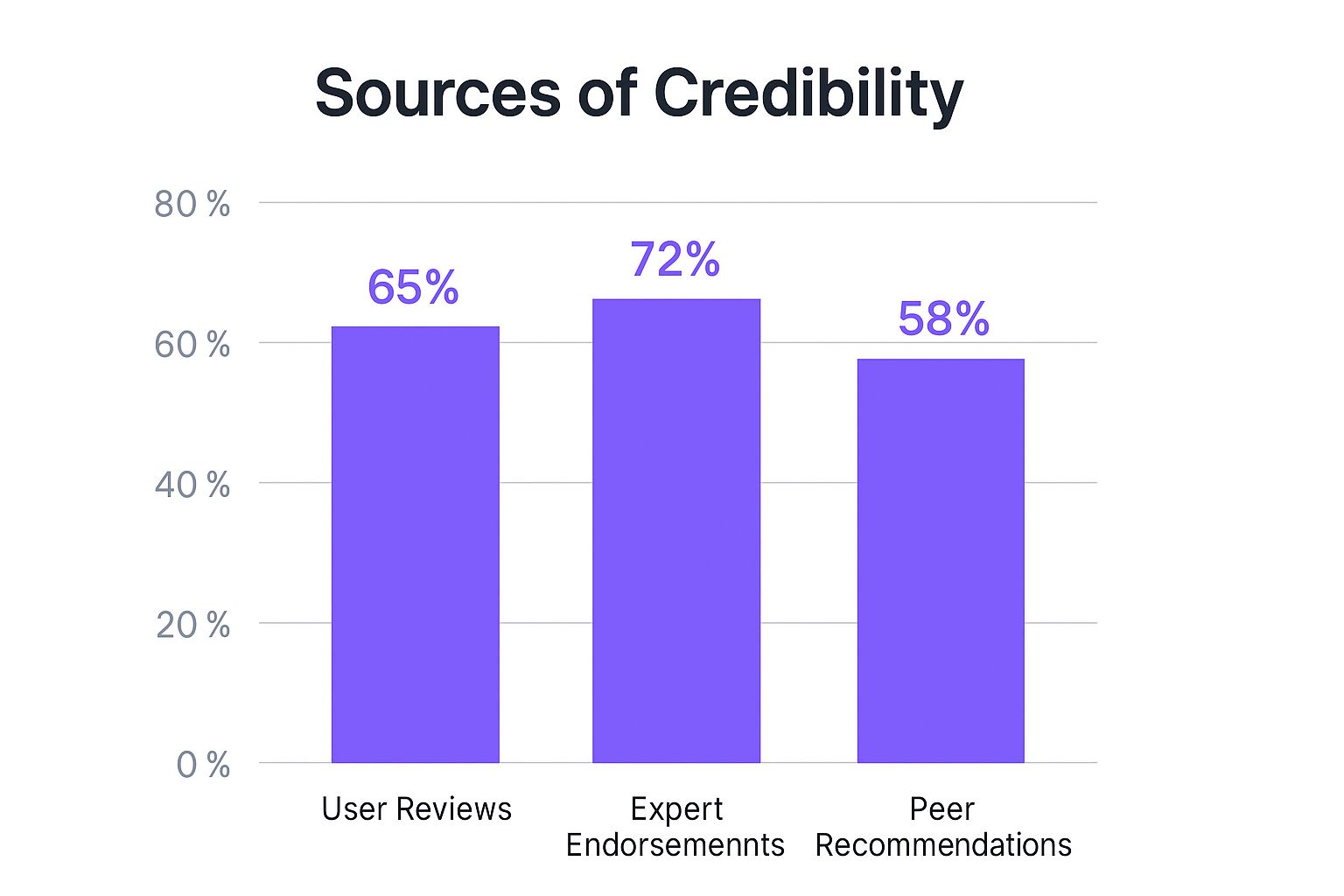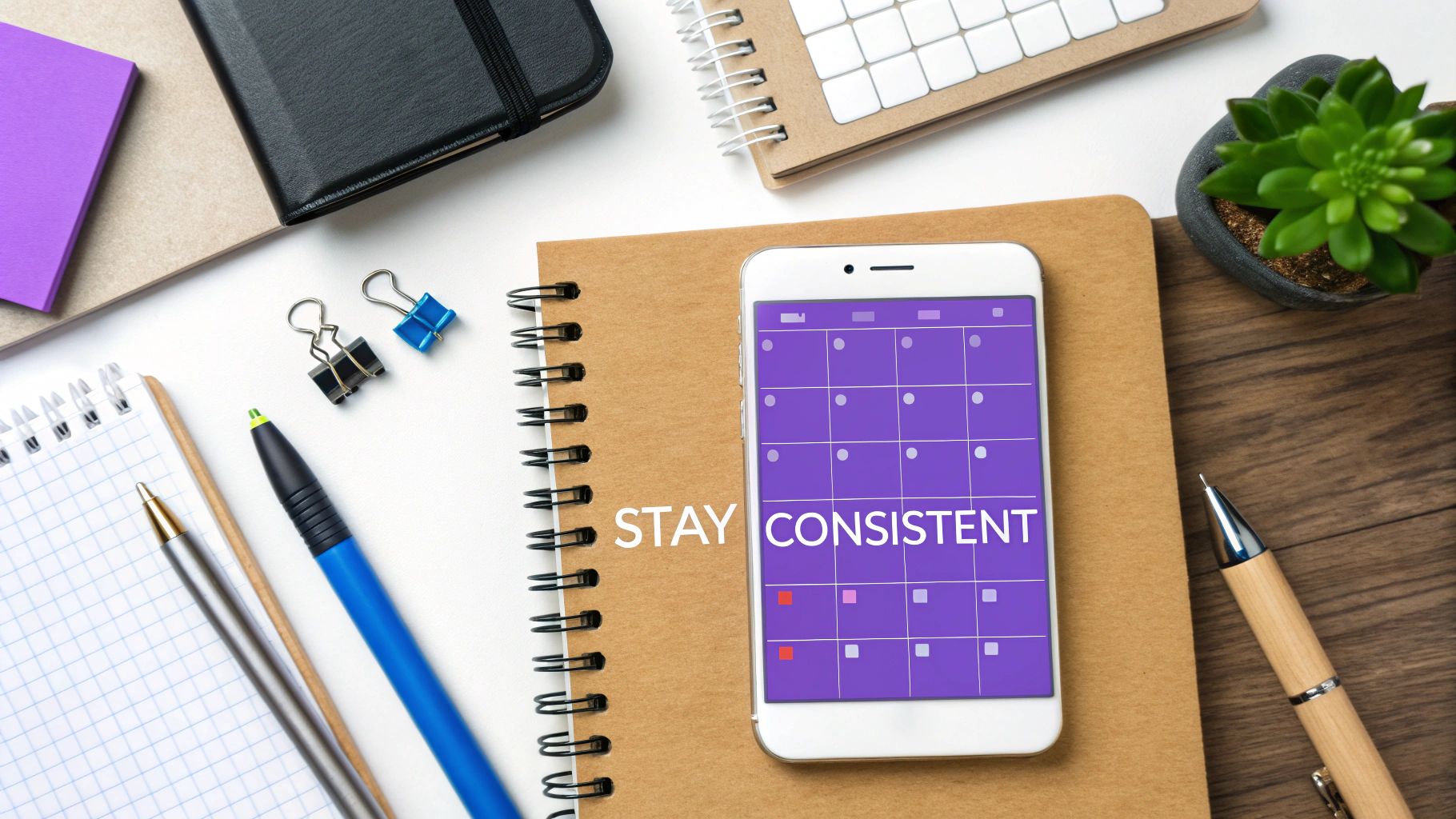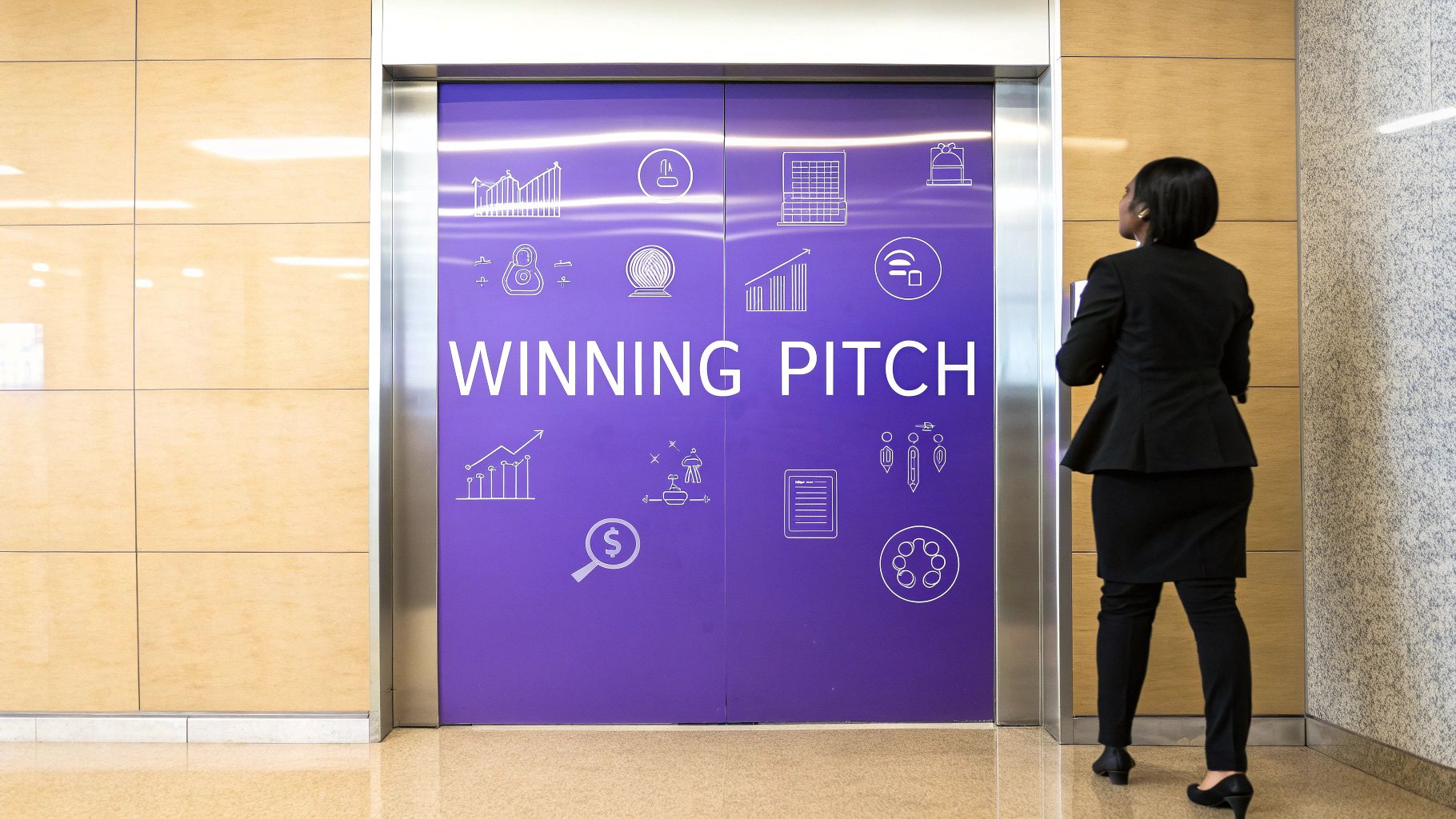How to Build Credibility and Become a Trusted Expert

Building credibility isn't some abstract concept.Building credibility isn't some abstract concept. It really boils down to three things: consistently proving your expertise, showing you're reliable, and always acting with integrity. This isn't something that happens overnight. It's a deliberate process of earning trust through your content, your actions, and your reputation, which is what separates you from just another voice online and makes you a trusted authority.
Why Credibility Is Your Most Valuable Asset
In a world drowning in information and opinions, credibility isn't just a nice-to-have; it's the currency of professional success. Think of it as a powerful filter that helps people decide who to listen to, who to hire, and who to trust. Without it, even the most brilliant ideas can fall on deaf ears, and real talent can go completely unnoticed. When you build that foundation of trust, opportunities start coming to you, so you're not constantly chasing them.
The big challenge? Trust is incredibly fragile and, frankly, in short supply. A recent Edelman Trust Barometer study drives this home, showing that trust in major institutions like the media is at a staggering low. This reality makes building personal credibility more critical—and more valuable—than ever before.
The Core Pillars of a Trusted Reputation
So, how do you actually start building this essential asset? It all starts with understanding what it's made of. I like to think of credibility as a structure held up by three distinct but tightly connected pillars.
To make this easier to digest, here's a simple breakdown of what I call "The Three Pillars of Credibility." Each one represents a core component you need to actively cultivate to build a reputation that lasts.
| Pillar | Description | Key Actions |
|---|---|---|
| Expertise | This is all about knowing your stuff, inside and out. It’s the specialized knowledge you have in your field, backed by real skill. | Create insightful content, share deep industry knowledge, and offer solutions to complex problems. |
| Reliability | This pillar is built on a simple foundation: consistency. It’s about being dependable and delivering on what you promise, every single time. | Meet your deadlines, maintain high standards in your work, and show up consistently for your audience. |
| Integrity | This is the bedrock of all trust. It’s about being honest, transparent, and ethical, even when no one is watching. | Be transparent in your dealings, align your actions with your words, and operate with a strong moral compass. |
By focusing on these three areas, you're not just hoping for credibility; you're actively building it, piece by piece.

The data in this chart is pretty telling. It clearly shows that endorsements from established experts carry the most weight. This really underscores the importance of building a reputation that’s recognized not just by your clients, but by your peers and other authorities in your field.
A Consultant's First Big Test
Let's make this real. Imagine a new marketing consultant trying to land their first major client. They might have the skills—the expertise is there—but the potential client is hesitating. Why? Because there's no track record. No proof of past success.
The consultant's first move isn't to create a flashy ad. It's to start a blog where they share hyper-specific advice for businesses in their target industry. That content becomes their primary tool for demonstrating expertise and beginning the slow, steady process of building trust.
By consistently publishing valuable, problem-solving content, they start to build a name for themselves. This journey from being a complete unknown to a respected voice is a perfect illustration of credibility in action. It’s never about one single grand gesture, but a long series of small, consistent actions that prove your worth over time. Mastering this process is absolutely fundamental if you want to become a thought leader in your space.
Create Content That Proves Your Expertise

If you want to build credibility online, your content is where the rubber meets the road. It’s your public portfolio and your digital handshake, proving what you know long before anyone speaks to you.
When you consistently put out content that genuinely solves problems, you’re not just sharing information. You're building a reputation with every single blog post, video, or case study you publish. It’s time to stop just saying you're an expert and start showing it.
Pinpoint Your Unique Value
Before you write a single word, you have to figure out what makes your perspective different. In a sea of noise, just echoing what everyone else says is a fast track to being ignored. You need to find a specific corner of your industry where your voice can be the most trusted one.
Ask yourself these questions to find your angle:
- What common industry problems do I have a totally different take on?
- What personal screw-ups or wins have given me a unique viewpoint?
- What new trend can I explain better and more clearly than anyone else?
The answers will lead you to that sweet spot where your knowledge meets your audience’s biggest needs. That’s where truly valuable content lives. For instance, a financial advisor could talk about saving money, or they could get hyper-specific and create a framework for first-generation wealth builders, using their own story as a guide. That kind of specificity is what builds a loyal following.
Choose Formats That Showcase Your Strengths
Not all content formats are built the same. The right one for you depends on your topic and, just as importantly, where you shine. The goal is to pick a medium that lets your expertise feel natural and authentic.
Your content strategy should feel less like a chore and more like a natural extension of how you already think and communicate. If you're a great storyteller, case studies might be your sweet spot. If you excel at clear, step-by-step instruction, how-to guides or video tutorials are perfect.
Think about using a mix of formats to hit different learning styles and drive your message home across platforms:
- Deeply Researched Articles: These are perfect for planting your flag as an authority on a complex topic. They prove you've done the homework and can turn dense information into real-world advice.
- Detailed Case Studies: Nothing screams "I know what I'm doing" like a real success story. Case studies walk people through your process and, more importantly, the results you deliver.
- Insightful Video Tutorials: Video lets you connect on a more personal level. It’s a great way to show your skills in action and break down tough subjects visually.
- Opinion Pieces: This is your chance to share your unique take on industry news or trends. It’s where you can start to shape the conversation and really stand out.
If you’re ready to move from just being an expert to being a voice people follow, it’s worth learning how to become a thought leader. Making that shift is a huge step in building a reputation that lasts.
Develop a Sustainable Content Engine
Consistency is everything. A few random posts here and there won’t build any real momentum. You need a schedule you can actually stick with for the long haul to cement yourself as a reliable source.
A classic mistake is aiming for an insane output, like daily posts, which almost always leads to burnout. It's better to focus on quality over quantity. One killer, well-researched article a month is way more valuable than four shallow posts. To pull this off, you have to get good at creating high-impact material efficiently. For some solid tips on that, check out our guide on how to create engaging content.
Your content is your legacy. When you focus on genuine value, pick the right formats, and keep a steady rhythm, you turn it from a marketing task into a powerful testament to your expertise.
Harness the Power of Social Proof and Testimonials

Creating great content shows what you know, but social proof is what convinces everyone else you know it. Credibility isn't something you can just claim for yourself; it’s earned when other people vouch for your work. This kind of validation is one of the most powerful trust-builders you have.
Think about it. We’ve all seen a restaurant with a line out the door and immediately assumed the food must be incredible. The same logic applies online. When potential clients see that others have worked with you and loved the results, they’re far more likely to take a chance on you. Research backs this up—with over 90% of consumers reading online reviews before buying, it’s clear we look to others to guide our decisions.
Ethically Collecting Powerful Testimonials
The best testimonials are specific, authentic, and packed with results. Getting them is all about timing and your approach. You don't want to sound needy. The perfect moment to ask is right after a client has expressed their happiness with your work or when you've just delivered a major win.
Forget the generic "Could you write me a testimonial?" email. Instead, make it personal and frame the request around their success.
Here’s an example of how I might ask:
"I'm so thrilled we were able to achieve [specific, positive result] together. Your feedback is incredibly valuable, and I was wondering if you’d be open to sharing a few sentences about your experience? It would be a huge help for others who are facing similar challenges."
Making it easy for them is key. I often offer to send a few guiding questions or even draft a version based on their past praise that they can quickly approve or edit. This removes all the friction and dramatically increases the odds of getting a killer testimonial you can actually use.
Turn Customer Wins into Compelling Case Studies
Testimonials are fantastic for a quick dose of social proof. But if you really want to show off your problem-solving chops, you need case studies. A powerful case study goes way beyond a simple quote to tell a complete and persuasive story.
I’ve found the most effective case studies follow a simple narrative:
- The Challenge: Start by clearly defining the problem the client was up against before they hired you. Using their own words makes it incredibly relatable.
- The Solution: This is where you pull back the curtain. Detail the specific strategies and actions you took to solve their problem. It’s your chance to really demonstrate your expertise in action.
- The Result: Hit them with the hard numbers. Did you boost revenue by 40%? Did you save them 25 hours per month on a tedious process? Concrete data is always more convincing than vague claims.
This structure transforms a simple client success into a powerful story that shows potential customers not just that you get results, but exactly how you do it.
Amplify Your Authority with External Validation
Beyond direct feedback from clients, other forms of validation can give your credibility a serious boost. These signals show that your expertise isn't just recognized by the people paying you, but by the wider industry.
You should always be on the lookout for opportunities to collect and display these authority-builders:
- Media Mentions: Getting featured or quoted in a respected industry publication is like getting a third-party seal of approval.
- Industry Awards: Any official award or recognition is an undeniable stamp of excellence from your peers.
- Collaborations: When you partner with other well-known experts or brands, their credibility rubs off on you.
All these pieces work together to build a full picture of your authority. For a deeper dive into the psychology of why this works so well, our guide on what social proof is in marketing is a great read. Even smaller signals, like professional acknowledgements on networking sites, play a role. For example, understanding LinkedIn endorsements is a good way to appreciate this other form of peer validation.
By strategically showcasing these different forms of social proof, you stop telling people you're an expert and start showing them.
Build a Reputation for Unshakeable Reliability
Expertise might get your foot in the door, but it's reliability that keeps you in the room. Anyone can have a one-off success—a fluke, a lucky break. What really builds credibility is a track record of consistently delivering on your promises. This is how you go from being "capable" to being seen as downright indispensable.
Think about it. Reliability isn't just about hitting deadlines. It's the entire experience you create. It’s about being the person who does what they say they'll do, time and time again. That consistent follow-through is what builds real, lasting trust and cements your reputation as a pro people can count on.
Set Clear Expectations from the Start
The bedrock of reliability is clarity. Nothing erodes trust faster than misunderstandings and missed expectations, even with the best intentions. Before you even think about starting a project, take the lead and define what a "win" looks like for everyone involved.
Get specific about the nuts and bolts:
- Deliverables: What exactly are you producing? No vague descriptions.
- Timelines: When are the milestones? What’s the final due date?
- Communication: How often will you check in? And through what channels (email, Slack, a weekly call)?
- Scope: What's included in the project? And just as crucial, what's not included?
When you proactively nail down these rules, you kill ambiguity before it can cause problems. Everyone is on the same page, which builds confidence in your process from day one.
Master the Art of Proactive Communication
Let's be real: things go wrong. Projects hit snags. Timelines shift. How you handle these moments is a massive test of your reliability and a huge factor in building your credibility. The absolute worst thing you can do is go dark and hope nobody notices.
Proactive communication is your secret weapon. When you hit a roadblock, don't wait for someone to chase you down for an update. Reach out immediately, explain the situation clearly, and come to the table with a solution or a revised plan.
This does more than just manage a hiccup; it shows integrity. It proves you're in control even when things aren't perfect, and it shows you respect your clients and colleagues enough to keep them in the loop. Honestly, this kind of transparency can build more trust than if everything had gone perfectly.
Consistency Is Your Most Powerful Tool
Every single interaction, no matter how small, is a chance to reinforce your reputation for being dependable. I'm talking about everything from answering emails promptly to maintaining the same high quality of work on every single task.
You see this principle play out in huge industries. Take construction, for example. Credibility is built on consistent, quality work. Between 2010 and 2023, the global building floor area shot up by 2% annually. But here’s the kicker: a shocking 50% of those new constructions failed to meet energy codes, according to a recent Global Status Report. This gap highlights a massive credibility problem for builders and regulators alike. Growth without consistent quality just doesn't build trust.
Your personal brand operates on the same logic. Every project you nail and every deadline you meet adds another brick to your wall of credibility. This steady performance becomes your brand, making you the go-to person when the stakes are high. And that level of reliability is a magnet for new clients—a critical part of any strategy for lead generation for small businesses. When people know they can count on you, they don’t just come back; they send others your way.
Connect Authentically Through Transparency and Empathy

Expertise and reliability are the foundation of any professional reputation. But the mortar holding it all together? That’s authentic human connection. At the end of the day, people don’t trust brands or algorithms; they trust other people.
This is where transparency and empathy become your most powerful tools for building real credibility. These aren't just soft skills—they're strategic assets. When you're open about your process, upfront with pricing, and even honest about your mistakes, you create a sense of trust that no amount of polished marketing can ever replicate.
Embrace Radical Transparency
Being transparent can feel a bit counterintuitive. Our first instinct is often to hide our flaws and project a perfect, polished image. The problem is, that perfection can feel sterile and unapproachable, creating distance instead of connection.
Radical transparency does the exact opposite. It means being open about the things others might try to hide:
- Your Process: Walk people through how you work. Sharing the "why" behind your methods demystifies what you do and shows you have a thoughtful, intentional approach.
- Your Pricing: Don’t make potential clients jump through hoops to figure out your costs. Clear, upfront pricing signals confidence and fairness.
- Your Mistakes: This is the big one. When you mess up, owning it immediately and explaining how you'll fix it doesn't kill your credibility—it strengthens it. It proves you have integrity and are accountable.
Think about it. A friend who admits their struggles feels more real and trustworthy than one who pretends their life is perfect. The same principle applies here. Your willingness to be open is essential for building a strong personal brand online.
Admitting you were wrong is one of the fastest ways to prove you’re right—right about your values, right about your commitment to integrity, and right about deserving someone’s trust. It turns a potential negative into a powerful positive.
Communicate with Genuine Empathy
Empathy isn't just about listening; it's about truly understanding and acting on your audience's needs, fears, and goals. It’s the ability to see the world from their perspective, which allows you to communicate in a way that resonates on a much deeper level.
When you communicate with empathy, you're not just broadcasting your expertise. You're starting a two-way conversation that shows you see, hear, and respect the person on the other side. This approach immediately disarms suspicion and builds rapport.
This connection is so important that in the customer experience world, a major survey of over 360,000 U.S. customer experience leaders found that 80% endorse using tools to analyze customer sentiment and trustworthiness. It just goes to show how critical it is to understand an audience's emotional state.
Practical Frameworks for Connection
Putting these ideas into practice requires a conscious shift in how you interact with your audience, whether they're clients, readers, or followers. For example, mastering social media for authors is a fantastic way to build a community by applying these principles.
Here are a few actionable frameworks to guide your communication:
- The "Feel, Felt, Found" Method: When someone raises a concern, start by validating their feelings. "I understand how you feel." Then, share a relatable experience: "Others have felt that way before." Finally, offer a resolution: "But what we have found is that [solution] works best." This shows you're listening and gently moves the conversation toward a positive outcome.
- The Active Listening Loop: Instead of just waiting for your turn to talk, actively reflect on what you’re hearing. Phrases like, "So if I'm understanding correctly, your biggest concern is..." prove you're engaged and ensure you’re both on the same page.
- Share the "Why": Behind every decision or piece of advice is a reason. Don't just tell people what to do; explain why it's the right move. This gives them the context they need to trust your judgment and feel like a true partner in the process.
Ultimately, people give their trust to those who they feel genuinely care about them and their success. By leading with transparency and empathy, you build a reputation that isn't just respected for its expertise but is also valued for its humanity.
Got Questions About Building Credibility? We’ve Got Answers.
When you first start thinking about building your professional reputation, a lot of questions pop up. It’s a journey that takes patience and a smart approach, so it's natural to wonder what really works. Let's tackle some of the most common questions to give you some clarity and real-world advice.
How Long Does It Really Take to Build Professional Credibility?
There's no magic number here, but let's be real: this is a marathon, not a sprint. Depending on your industry, where you're starting from, and how consistently you show up, you should plan on 6 to 12 months of focused effort before you start seeing real, tangible results.
What do those results look like? It could be unsolicited praise from a peer, an inbound lead from someone who found your work, or an invitation to speak at an industry event. Every solid piece of content, every successful project, and every promise you keep is another brick in the foundation.
The trick is to stop looking for an overnight success story and start celebrating the small, consistent wins. True credibility is earned over time, one high-quality interaction at a time. It’s the cumulative effect of your reliability that builds a reputation that sticks.
Think of it like planting a tree. You won't see much happening in the first few weeks, but with consistent care, it eventually develops deep roots and becomes a strong, noticeable presence in the landscape.
Can I Build Credibility Without a Huge Social Media Following?
Absolutely. This is one of the biggest myths out there. Credibility isn't about follower count; it’s about the quality and depth of your reputation within the community that actually matters. You can build immense trust and authority with a small, highly-engaged group of people.
Your goal isn't to be famous—it's to be trusted by the right people. So, where should you focus your energy? Go where your target audience already is and contribute meaningfully.
- Niche Online Forums: Become a helpful, go-to voice in a specialized subreddit or an industry-specific forum.
- LinkedIn Groups: Don't just lurk. Share insightful comments and ask thoughtful questions in groups where your ideal clients or colleagues hang out.
- Industry Events: Whether it's a webinar or a local meetup, participate. Ask smart questions and connect with people on a personal level.
One deeply insightful article on a respected industry blog can build more authority and create more genuine connections than a thousand passive followers ever will. It's about impact, not just impressions.
What Is the Best Way to Handle a Mistake That Hurts My Credibility?
The only way through is to face it head-on, with total honesty and transparency. Trying to hide an error or downplay it will always cause more damage in the long run. In fact, when handled well, a mistake can actually strengthen the trust others have in you.
We saw a masterclass in this from Sam Altman of OpenAI. After his very public firing, he reflected on the situation, calling it a "big failure of governance by well-meaning people, myself included." By taking responsibility and focusing on rebuilding, he turned a potential career-killer into a lesson on leadership.
Here’s a simple, three-step framework to follow:
- Acknowledge and Own It: Address the mistake right away. Take full responsibility without pointing fingers or making excuses. A simple, "I messed up" is incredibly powerful.
- Communicate the Impact: Clearly explain what happened and what the consequences are. This shows you understand the gravity of the situation and respect everyone affected.
- Outline the Fix: Most importantly, detail the concrete steps you're taking to correct the issue and prevent it from happening again. This shows you're proactive and committed to integrity.
This approach demonstrates accountability and a commitment to doing the right thing—which are the cornerstones of a credible character.
How Do I Ask for Testimonials Without Sounding Needy?
The secret here is all about timing and a personal touch. You want to make the request when your value is fresh in your client's mind, making it feel like a natural end to a great project, not an awkward obligation.
The perfect moment is right after they've expressed satisfaction or you've delivered a big win. That's when their positive feelings are at their peak.
Forget the generic, automated email blasts. A personal note goes so much further.
Here's a template you can adapt:
"I'm so glad we were able to achieve [specific, positive result] together! It was a real pleasure working with you on this.
As I grow my business, stories like yours are incredibly helpful for others who are trying to solve similar problems. Would you be open to sharing a few sentences about your experience working with me?"
To make it even easier for them, you can offer a few guiding questions like, "What was the biggest challenge you faced before we started?" or "What was the most significant outcome of our work together?" This removes the friction of staring at a blank page and helps them give you the specific, results-driven feedback that builds the most powerful credibility.
Ready to build a professional presence that commands respect and opens doors? MakerBox is your AI-powered partner for creating a credible and engaging online identity. Our platform helps you generate optimized bios, stunning profile photos, and compelling content that showcases your expertise. Transform your profiles on LinkedIn, X, and more in just 30 seconds. Start building the credibility you deserve today at https://www.makerbox.io.





